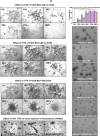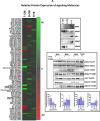Anti-tumor and immune modulating activity of T cell induced tumor-targeting effectors (TITE)
- PMID: 32865605
- PMCID: PMC7914128
- DOI: 10.1007/s00262-020-02692-8
Anti-tumor and immune modulating activity of T cell induced tumor-targeting effectors (TITE)
Abstract
Adoptive transfer of Bispecific antibody Armed activated T cells (BATs) showed promising anti-tumor activity in clinical trials in solid tumors. The cytotoxic activity of BATs occurs upon engagement with tumor cells via the bispecific antibody (BiAb) bridge, which stimulates BATs to release cytotoxic molecules, cytokines, chemokines, and other signaling molecules extracellularly. We hypothesized that the release of BATs Induced Tumor-Targeting Effectors (TITE) by this complex interaction of T cells, bispecific antibody, and tumor cells may serve as a potent anti-tumor and immune-activating immunotherapeutic approach. In a 3D tumorsphere model, TITE showed potent cytotoxic activity against multiple breast cancer cell lines compared to control conditioned media (CM): Tumor-CM (T-CM), BATs-CM (B-CM), BiAb Armed PBMC-CM (BAP-CM) or PBMC-CM (P-CM). Multiplex cytokine analysis showed high levels of Th1 cytokines and chemokines; phospho-protein signaling array data suggest that the prominent JAK1/STAT1 pathway may be responsible for the induction and release of Th1 cytokines/chemokines in TITE. In xenograft breast cancer models, IV injections of 10× concentrated TITE (3×/week for 3 weeks; 150 μl TITE/injection) was able to inhibit tumor growth significantly (ICR/scid, p < 0.003; NSG p < 0.008) compared to the control mice. We tested the key components of the TITE for immune activating and anti-tumor activity individually and in combinations, the combination of IFN-γ, TNF-α and MIP-1β recapitulates the key activities of the TITE. In summary, master mix of active components of BATs-Tumor complex-derived TITE can provide a clinically controllable cell-free platform to target various tumor types regardless of the heterogeneous nature of the tumor cells and mutational tumor.
Keywords: 3D culture model; Activated T cells; Bispecific antibody; Breast cancer; Cancer stem cells; Myeloid-derived suppressor cells; Th1 cytokines.
Conflict of interest statement
AT is co-founder of Nova Immune Platform Inc.; LGL is co-founders of TransTarget, Inc; SVK, KJ, DLS, EB, JU, AA, EC and BFS have no conflict of interest. The data presented in this manuscript are original and have not been published elsewhere except in the form of abstracts and poster presentations at symposia and meetings.
Figures












Similar articles
-
Broad reactivity and enhanced potency of recombinant anti-EGFR × anti-CD3 bispecific antibody-armed activated T cells against solid tumours.Ann Med. 2022 Dec;54(1):1047-1057. doi: 10.1080/07853890.2022.2059101. Ann Med. 2022. PMID: 36799362 Free PMC article.
-
Co-Stimulatory Bispecific Antibodies Induce Enhanced T Cell Activation and Tumor Cell Killing in Breast Cancer Models.Front Immunol. 2021 Aug 16;12:719116. doi: 10.3389/fimmu.2021.719116. eCollection 2021. Front Immunol. 2021. PMID: 34484225 Free PMC article.
-
Enhanced cytotoxicity in multiple myeloma via T cells armed with bispecific T cell engager targeting B-cell maturation antigen on cancer cells and CD3 on T cells.Int Immunopharmacol. 2024 Dec 25;143(Pt 2):113480. doi: 10.1016/j.intimp.2024.113480. Epub 2024 Oct 29. Int Immunopharmacol. 2024. PMID: 39467352
-
Activated T cells armed with bispecific antibodies kill tumor targets.Curr Opin Hematol. 2015 Nov;22(6):476-83. doi: 10.1097/MOH.0000000000000176. Curr Opin Hematol. 2015. PMID: 26457960 Review.
-
Cancer therapy with antibodies.Nat Rev Cancer. 2024 Jun;24(6):399-426. doi: 10.1038/s41568-024-00690-x. Epub 2024 May 13. Nat Rev Cancer. 2024. PMID: 38740967 Free PMC article. Review.
Cited by
-
A Yeast Cell Wall Derived Hybrid Hydrogel with Photothermal and Immune Combined Modality Therapy for Enhanced Anti-Melanoma Efficacy.Int J Nanomedicine. 2023 Sep 21;18:5423-5440. doi: 10.2147/IJN.S409674. eCollection 2023. Int J Nanomedicine. 2023. PMID: 37767196 Free PMC article.
-
Bispecific antibody-targeted T-cell therapy for acute myeloid leukemia.Front Immunol. 2022 Nov 1;13:899468. doi: 10.3389/fimmu.2022.899468. eCollection 2022. Front Immunol. 2022. PMID: 36389764 Free PMC article.
-
Multifaceted Role of Vitamin D in Breast Cancer: A Systematic Review of Genetic and Pathway-Based Mechanisms.Asian Pac J Cancer Prev. 2024 Oct 1;25(10):3349-3361. doi: 10.31557/APJCP.2024.25.10.3349. Asian Pac J Cancer Prev. 2024. PMID: 39471001 Free PMC article.
-
ESCO2 promotes hypopharyngeal carcinoma progression in a STAT1-dependent manner.BMC Cancer. 2023 Nov 15;23(1):1114. doi: 10.1186/s12885-023-11527-5. BMC Cancer. 2023. PMID: 37968576 Free PMC article.
-
Breast cancer organoids and their applications for precision cancer immunotherapy.World J Surg Oncol. 2023 Oct 26;21(1):343. doi: 10.1186/s12957-023-03231-2. World J Surg Oncol. 2023. PMID: 37884976 Free PMC article. Review.
References
MeSH terms
Substances
Grants and funding
LinkOut - more resources
Full Text Sources
Medical
Research Materials
Miscellaneous

